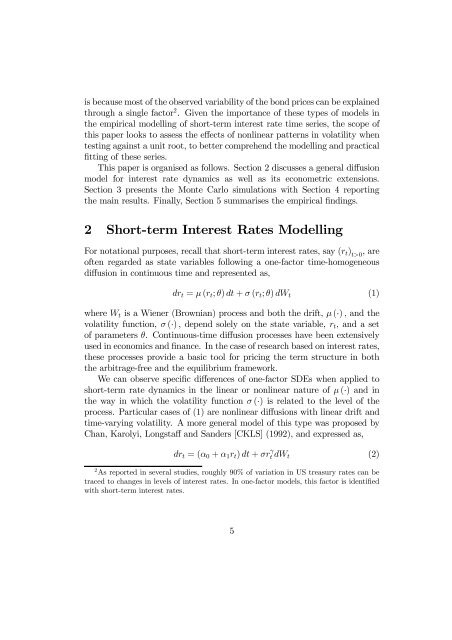on the small sample properties of dickey fuller and maximum ... - Ivie
You also want an ePaper? Increase the reach of your titles
YUMPU automatically turns print PDFs into web optimized ePapers that Google loves.
is because most <strong>of</strong> <strong>the</strong> observed variability <strong>of</strong> <strong>the</strong> b<strong>on</strong>d prices can be explained<br />
through a single factor 2 . Given<strong>the</strong>importance<strong>of</strong><strong>the</strong>setypes<strong>of</strong>modelsin<br />
<strong>the</strong> empirical modelling <strong>of</strong> short-term interest rate time series, <strong>the</strong> scope <strong>of</strong><br />
this paper looks to assess <strong>the</strong> effects <strong>of</strong> n<strong>on</strong>linear patterns in volatility when<br />
testing against a unit root, to better comprehend <strong>the</strong> modelling <strong>and</strong> practical<br />
fitting <strong>of</strong> <strong>the</strong>se series.<br />
This paper is organised as follows. Secti<strong>on</strong> 2 discusses a general diffusi<strong>on</strong><br />
model for interest rate dynamics as well as its ec<strong>on</strong>ometric extensi<strong>on</strong>s.<br />
Secti<strong>on</strong> 3 presents <strong>the</strong> M<strong>on</strong>te Carlo simulati<strong>on</strong>s with Secti<strong>on</strong> 4 reporting<br />
<strong>the</strong> main results. Finally, Secti<strong>on</strong> 5 summarises <strong>the</strong> empirical findings.<br />
2 Short-term Interest Rates Modelling<br />
For notati<strong>on</strong>al purposes, recall that short-term interest rates, say (r t ) t>0<br />
,are<br />
<strong>of</strong>ten regarded as state variables following a <strong>on</strong>e-factor time-homogeneous<br />
diffusi<strong>on</strong> in c<strong>on</strong>tinuous time <strong>and</strong> represented as,<br />
dr t = µ (r t ; θ) dt + σ (r t ; θ) dW t (1)<br />
where W t is a Wiener (Brownian) process <strong>and</strong> both <strong>the</strong> drift, µ (·) , <strong>and</strong> <strong>the</strong><br />
volatility functi<strong>on</strong>, σ (·) , depend solely <strong>on</strong> <strong>the</strong> state variable, r t , <strong>and</strong> a set<br />
<strong>of</strong> parameters θ. C<strong>on</strong>tinuous-time diffusi<strong>on</strong> processes have been extensively<br />
used in ec<strong>on</strong>omics <strong>and</strong> finance. In <strong>the</strong> case <strong>of</strong> research based <strong>on</strong> interest rates,<br />
<strong>the</strong>se processes provide a basic tool for pricing <strong>the</strong> term structure in both<br />
<strong>the</strong> arbitrage-free <strong>and</strong> <strong>the</strong> equilibrium framework.<br />
We can observe specific differences <strong>of</strong> <strong>on</strong>e-factor SDEs when applied to<br />
short-term rate dynamics in <strong>the</strong> linear or n<strong>on</strong>linear nature <strong>of</strong> µ (·) <strong>and</strong> in<br />
<strong>the</strong> way in which <strong>the</strong> volatility functi<strong>on</strong> σ (·) is related to <strong>the</strong> level <strong>of</strong> <strong>the</strong><br />
process. Particular cases <strong>of</strong> (1) are n<strong>on</strong>linear diffusi<strong>on</strong>s with linear drift <strong>and</strong><br />
time-varying volatility. A more general model <strong>of</strong> this type was proposed by<br />
Chan, Karolyi, L<strong>on</strong>gstaff <strong>and</strong> S<strong>and</strong>ers [CKLS] (1992), <strong>and</strong> expressed as,<br />
dr t =(α 0 + α 1 r t ) dt + σr γ t dW t (2)<br />
2 As reported in several studies, roughly 90% <strong>of</strong> variati<strong>on</strong> in US treasury rates can be<br />
traced to changes in levels <strong>of</strong> interest rates. In <strong>on</strong>e-factor models, this factor is identified<br />
with short-term interest rates.<br />
5

















